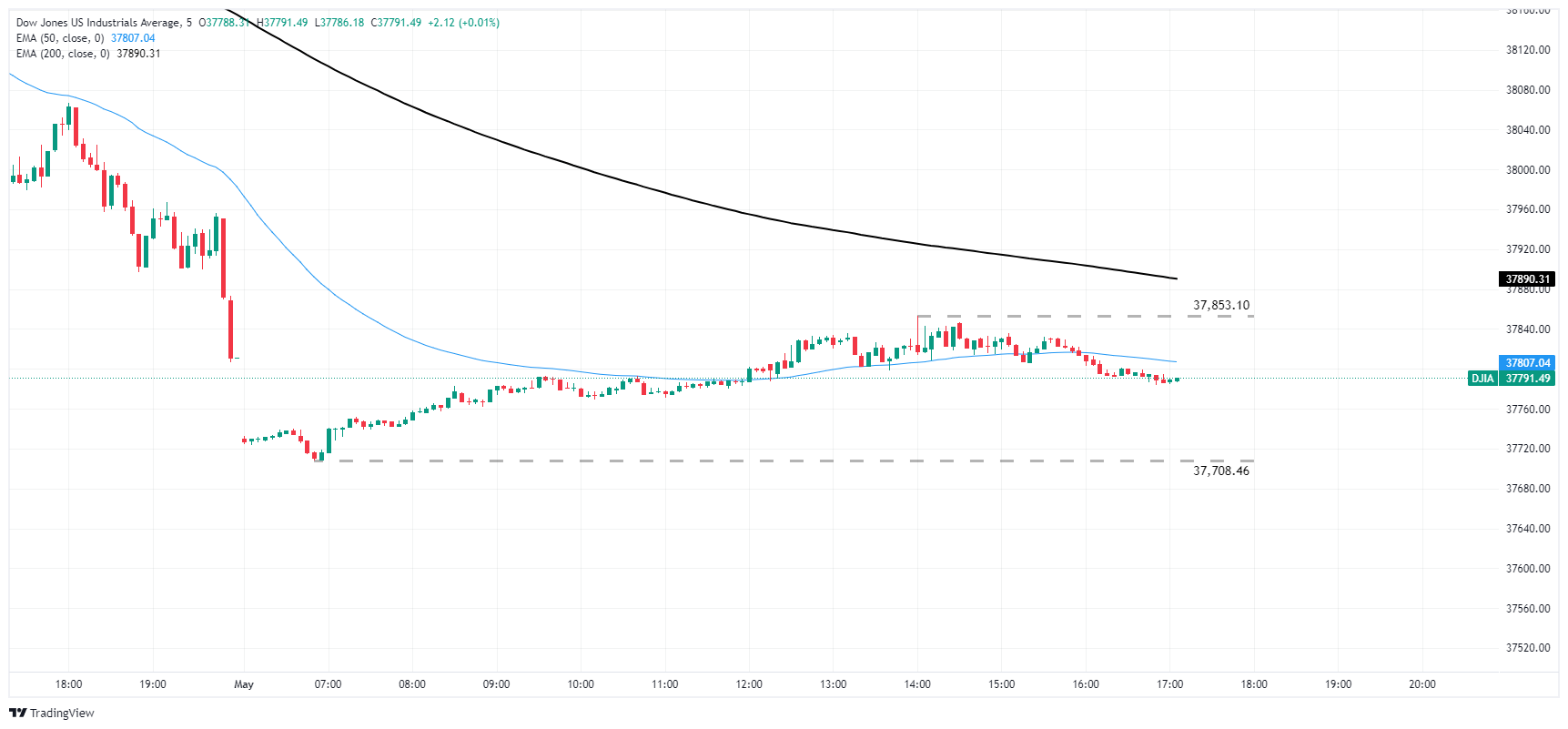Dow Jones stuck near recent lows as Fed looms.
Equities are mixed as markets await Fed policy guidance.
NFP Friday will solidify market outlook on US labor market.
After this week’s backslide, the Dow Jones Industrial Average (DJIA) is stuck in a rut, dragging the index below 38,000.00 as investors buckle down for another rate call from the US Federal Reserve (Fed). With rates broadly expected to hold steady this week, investors will be looking for firmer clues about when the Fed could be expected to begin cutting interest rates.
US Interest Rate Decision: Fed set to keep policy steady as markets reassess timing of rate cuts
The US ISM Manufacturing Purchasing Managers Index (PMI) for April came in softer than expected, but Wednesday morning’s April ADP Employment Change came in above forecasts. Despite a declining US economic outlook, a tight labor market makes it difficult for the Fed to adjust policy rates without drastic knock-on effects that could include re-igniting inflation, which still remains higher than many hoped.
Read more:
US ADP Employment Change increases above consensus in April
US ISM Manufacturing PMI drops to 49.2 in April vs 50.0 expected
Dow Jones news
Of the 30 securities that comprise the Dow Jones, around half of them are trading in the red on Wednesday as markets pull into the midrange ahead of the latest Federal Open Market Committee (FOMC) appearance. Nike Inc. (NKE) is down around 1.8% on the day, with Johnson & Johnson (JNJ) and 3M Co. (MMM) dragging the index higher, up 4.3% and 2.5%, respectively.
Dow Jones technical outlook
The Dow Jones continues to struggle with the 38,000.00 handle, kicking Wednesday off with a dip to 37,708.46 before recovering into the previous day’s closing bids. The major equity index continues to trade into the low side, eating away at chart paper as the Dow Jones heads back towards the 200-day Exponential Moving Average (EMA) at 36,780.70.
Dow Jones five-minute chart
Dow Jones daily chart
Dow Jones FAQs
The Dow Jones Industrial Average, one of the oldest stock market indices in the world, is compiled of the 30 most traded stocks in the US. The index is price-weighted rather than weighted by capitalization. It is calculated by summing the prices of the constituent stocks and dividing them by a factor, currently 0.152. The index was founded by Charles Dow, who also founded the Wall Street Journal. In later years it has been criticized for not being broadly representative enough because it only tracks 30 conglomerates, unlike broader indices such as the S&P 500.
Many different factors drive the Dow Jones Industrial Average (DJIA). The aggregate performance of the component companies revealed in quarterly company earnings reports is the main one. US and global macroeconomic data also contributes as it impacts on investor sentiment. The level of interest rates, set by the Federal Reserve (Fed), also influences the DJIA as it affects the cost of credit, on which many corporations are heavily reliant. Therefore, inflation can be a major driver as well as other metrics which impact the Fed decisions.
Dow Theory is a method for identifying the primary trend of the stock market developed by Charles Dow. A key step is to compare the direction of the Dow Jones Industrial Average (DJIA) and the Dow Jones Transportation Average (DJTA) and only follow trends where both are moving in the same direction. Volume is a confirmatory criteria. The theory uses elements of peak and trough analysis. Dow’s theory posits three trend phases: accumulation, when smart money starts buying or selling; public participation, when the wider public joins in; and distribution, when the smart money exits.
There are a number of ways to trade the DJIA. One is to use ETFs which allow investors to trade the DJIA as a single security, rather than having to buy shares in all 30 constituent companies. A leading example is the SPDR Dow Jones Industrial Average ETF (DIA). DJIA futures contracts enable traders to speculate on the future value of the index and Options provide the right, but not the obligation, to buy or sell the index at a predetermined price in the future. Mutual funds enable investors to buy a share of a diversified portfolio of DJIA stocks thus providing exposure to the overall index.
Information on these pages contains forward-looking statements that involve risks and uncertainties. Markets and instruments profiled on this page are for informational purposes only and should not in any way come across as a recommendation to buy or sell in these assets. You should do your own thorough research before making any investment decisions. FXStreet does not in any way guarantee that this information is free from mistakes, errors, or material misstatements. It also does not guarantee that this information is of a timely nature. Investing in Open Markets involves a great deal of risk, including the loss of all or a portion of your investment, as well as emotional distress. All risks, losses and costs associated with investing, including total loss of principal, are your responsibility. The views and opinions expressed in this article are those of the authors and do not necessarily reflect the official policy or position of FXStreet nor its advertisers. The author will not be held responsible for information that is found at the end of links posted on this page.
If not otherwise explicitly mentioned in the body of the article, at the time of writing, the author has no position in any stock mentioned in this article and no business relationship with any company mentioned. The author has not received compensation for writing this article, other than from FXStreet.
FXStreet and the author do not provide personalized recommendations. The author makes no representations as to the accuracy, completeness, or suitability of this information. FXStreet and the author will not be liable for any errors, omissions or any losses, injuries or damages arising from this information and its display or use. Errors and omissions excepted.
The author and FXStreet are not registered investment advisors and nothing in this article is intended to be investment advice.
>>> Read full article>>>
Copyright for syndicated content belongs to the linked Source : FXStreet – https://www.fxstreet.com/news/dow-jones-industrial-average-struggles-to-recover-from-recent-backslide-as-fed-rounds-corner-202405011713













![[News] Japan Develops 10nm Nanoimprint Technology, with Potential to Tackle EUV Bottleneck – TrendForce](https://earth-news.info/wp-content/uploads/2025/12/329851-news-japan-develops-10nm-nanoimprint-technology-with-potential-to-tackle-euv-bottleneck-trendforce-360x180.jpg)









![[News] Japan Develops 10nm Nanoimprint Technology, with Potential to Tackle EUV Bottleneck – TrendForce](https://earth-news.info/wp-content/uploads/2025/12/329851-news-japan-develops-10nm-nanoimprint-technology-with-potential-to-tackle-euv-bottleneck-trendforce-120x86.jpg)






